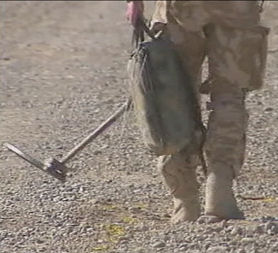Troops take lonely walk to defuse Afghan IEDs
Updated on 12 March 2010
Alex Thomson is given unique access to one of the British army's bomb-disposal units to find out the reality of defusing improvised explosive devices, the Taliban insurgents' weapon of choice in Afghanistan.

In the war of the IED - Improvised Explosive Device - it is the loneliest of lonely walks. The last 30 yards out from your colleagues, dropping off your cover man 20 yards out from the bomb, writes Alex Thomson.
On your own, you have the last few yards to yourself. You are going into the death zone. A place where if you make a mistake, no flack jacket or helmet will make the slightest difference.
Forget please, the absurd nonsense served up to us recently in The Hurt Locker. This is no world for mavericks or heroes: just close-knit, tight teamwork.
It starts with an urgent notification that an IED has been found. They call them ten-liners, emails of ten lines detailing everything known about the device. But teams like that led by "Woody", Staff Sergeant Gareth Wood of the Royal Logistic Core sometimes get more than ten such warnings in one day. At the bomb site, best forget everything you have seen about police cordons, crowd safety and other quaint British notions.
Clearly the Afghan locals all seem to know where the bombs are laid. They'll drive round columns of heavily armed military vehicles because they want to be on their way and to hell with Nato.
Instead of defusing the bomb, soldiers usually have to yell at people to go back from the bomb zone. Traffic must be halted. Warning flares fired if necessary. It all sort of works, eventually.
In the heat, tension and general sense of chaos the British team must also be mindful of an ambush. Nothing is more exposed and static than soldiers painstakingly feeling their way to a buried bomb, warily waving their mine detectors.
About the only thing the British have going for them, the Pashto word for mine, is mine.
Now for obvious reasons I'm not going to tell you, indeed I'm not allowed to tell you, what really goes on in the death zone. But the bombs are not the sophisticated devices used in Iraq or Northern Ireland.
So it is a matter of breaking the link between the pack of batteries wired into the detonator and the container of ammonium nitrate and sugar, or ammonium nitrate and aluminium depending on your recipe.
Variations abound, the team we filmed discovered both home-made explosive mixtures: pressure plate triggers, release pressure triggers, small devices and much larger ones of 40kg or more explosive.
Some of the defusing methods are almost quaintly old fashioned. No robots on the team we filmed, still less the Oscar-laden moon suits of The Hurt Locker. No no, this thing the British army think more along the lines of cables, hooks and elbow grease to haul bombs out of the road to a safe distance.
"It's surreal really, you're just in you're own world. It's my office I suppose" said Staff Sergeant Wood. "It's just what we do."
Though that extraordinary work ethic was seriously tested as we filmed bomb after bomb detected then defused. There were so many, our convoy drove past several before they were even discovered. But nobody dwells on lucky escapes.
After nine hours in the blazing heat with no break, yet another notification, a ten-liner: "Oh not another ******* bomb" as one of the team put it.
In the end running low on batteries, fuel, endurance, food, stamina, you name it - the IED team had no choice. All forensics, examination and bagging up of bomb parts, was forgotten n the race against the clock.
Even so the clock won. Edging towards exhaustion two more bombs on the way back to their camp, had to be left and marked for the next day.
All this on one section of road a few hundred yards long in one small part of one small district of Helmand province.





